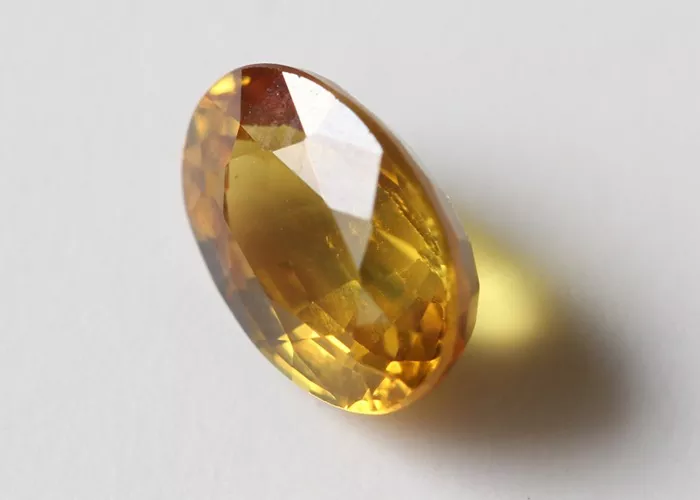Yellow sapphires, renowned for their mesmerizing hues ranging from light yellow to golden yellow, are a treasure trove in the world of gemstones. Their allure is not just confined to their aesthetic appeal but also stems from their intriguing formation process. This article aims to delve into the scientific origins of yellow sapphires, explaining how they are formed in a manner accessible to all.
The Basics of Yellow Sapphires
Yellow sapphires belong to the corundum mineral family, which includes both sapphires and rubies. The defining characteristic of corundum is its aluminum oxide composition (Al₂O₃). While rubies are distinguished by their red hues due to the presence of chromium, sapphires can exhibit a myriad of colors, including yellow, thanks to various trace elements present within their crystalline structure.
Yellow sapphires, in particular, owe their vibrant colors to iron and nickel impurities. These elements, when present in the right concentrations, interact with the corundum crystal lattice to produce a spectrum of yellow shades. The resulting gemstones can vary from a subtle pale yellow to a rich golden hue, each with its unique charm and rarity.
Formation Environment
Understanding the formation of yellow sapphires necessitates an exploration of their geological habitat. These gemstones are typically found in environments characterized by high temperatures and aluminum-rich, silicon-poor conditions. Such environments are prevalent in igneous rocks, particularly those derived from basaltic magmas rich in alumina.
The formation process begins deep within the Earth’s crust, where high temperatures and pressures facilitate the crystallization of minerals. In the case of yellow sapphires, their origin can be traced back to the crystallization phase of alumina-rich magmas. As these magmas cool and solidify, they create an environment conducive to the formation of corundum crystals.
The Crystallization Process
The crystallization of corundum, including yellow sapphires, involves a complex interplay between chemical composition, temperature, and pressure. Initially, the magma, rich in alumina and other minerals, begins to cool. As it does, the alumina becomes supersaturated, leading to the precipitation of corundum crystals.
During this stage, trace elements such as iron and nickel become incorporated into the growing crystal structure. The specific arrangement and concentration of these impurities within the crystal lattice determine the ultimate color of the sapphire. For instance, higher concentrations of iron can yield deeper yellow shades, while nickel may contribute to a more golden hue.
Discovery and Occurrence
Yellow sapphires have been discovered in various parts of the world, but two regions stand out prominently: Sri Lanka and Australia. These locations are geologically favorable for the formation of corundum gemstones, including yellow sapphires.
In Sri Lanka, yellow sapphires are often found in alluvial deposits, where ancient riverbeds have concentrated gem-bearing gravels over millions of years. The gemstones, eroded from their primary sources in the highlands, have been transported and deposited in lower-lying areas, making them accessible to miners.
Australia, on the other hand, boasts primary deposits where yellow sapphires are found in their original rock matrix. These deposits are typically associated with igneous rocks, such as those found in the Yilgarn Craton, a geological province known for its mineral richness.
Notable Discoveries
One of the most renowned yellow sapphires discovered to date is the “Star of Adam,” a magnificent 46.5-carat gemstone from Sri Lanka. This sapphire exemplifies the best qualities of yellow sapphires: a pure golden hue, exceptional clarity, and a brilliant reflective quality. Such gemstones are highly sought after for their rarity and beauty, often fetching exorbitant prices in the international gemstone market.
The Role of Geochemical Conditions
The formation of yellow sapphires is intricately linked to the geochemical conditions prevalent during their crystallization. High temperatures and pressures, combined with the right mix of alumina, silicon, and trace elements, create an optimal environment for corundum crystallization.
Moreover, the presence of specific minerals in the surrounding rock matrix can influence the crystal growth and, consequently, the quality of the resulting sapphire. For instance, the presence of titanium can sometimes contribute to the formation of rutile silk, a fibrous inclusion that can add to the gemstone’s asterism (a star-like pattern visible under certain lighting conditions).
Comparison with Other Yellow Gemstones
While yellow sapphires are unique in their own right, they share the yellow gemstone market with other notable gems, such as yellow diamonds, citrine, and topaz. Each of these gemstones possesses its own distinct characteristics and formation processes.
Yellow diamonds, for instance, owe their color to the presence of nitrogen impurities within their crystal structure. These gemstones are exceptionally rare and, consequently, highly valuable. Citrine, a variety of quartz, derives its yellow hue from heat treatment, transforming amethyst or smokey quartz into its vibrant yellow form. Topaz, on the other hand, can naturally occur in a range of colors, including yellow, due to trace elements such as fluorine and aluminum.
Conclusion
Yellow sapphires are a testament to the Earth’s incredible geological processes, combining high temperatures, pressure, and the right chemical composition to create gemstones of unparalleled beauty. Their formation, from the depths of the Earth’s crust to their eventual discovery and admiration, is a fascinating journey that highlights the intricate interplay of nature’s forces.
Related topic:
- How to Incorporate Diamonds Into a Sapphire Anniversary Ring
- 6 Reasons to Gift a Sapphire Ring for Your Next Anniversary
- The Journey of Masoala Sapphire: From Mine to Market


